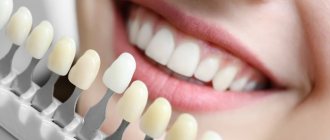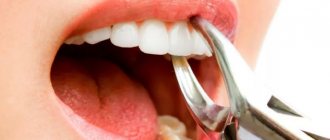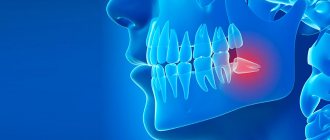We often hear from parents that it is not necessary to treat baby teeth. After all, they will fall out by themselves. But this popular belief is wrong. Baby teeth, of course, will fall out in due time, but their diseases can bring a lot of suffering to children, as well as damage the health of future permanent teeth - even to the point of malocclusion. Let's figure out whether baby teeth need to be treated, in what cases and how to do it.
Modern methods of treating primary teeth in children aged 2 to 4 years
Modern parents believe that treating a child’s teeth is a waste of time, because over time, milk teeth will be replaced by permanent, healthy teeth without caries.
But every pediatric dentist will call this opinion erroneous, since caries negatively affects not only the oral cavity, but also the condition of other organs and systems of the small patient. The reasons for the development of childhood caries are different. How do young children have their teeth treated today in the Russian Federation? This is done using a gentle method and using only the latest developments in dentistry. Therefore, during this procedure the baby does not experience any discomfort, much less fear.
From 2 to 4 years of age, pediatric dentistry uses the method of silvering baby teeth. A specially developed medicine is applied to the already damaged enamel. The drugs of choice are Saforide and Argenate - they contain 30% silver. After application, the dentin canals close and the spread of bacteria that cause caries stops. This procedure does not bother the baby at all, and he calmly sits for the required time in the chair.
The fluoridation procedure helps eliminate caries in children as reliably as the first method. There are two ways to go here. The first is the application of a fluoride-containing preparation with a brush to the tooth enamel. The second is treatment with a tampon, which is soaked in a special liquid. It contains copper and calcium hydroxide.
Dental treatment today is neither painful nor scary, and this is the main difference between dental offices and those that existed 20 or even 30 years ago. We use modern, effective anesthetics with different flavors, silent drills, and multi-colored fillings, the color of which the child can choose himself.
Features of treatment of children's teeth
Dental treatment in childhood requires compliance with a number of features. The methods are similar to those used for adults, but there are some differences. In general, pediatric dentistry is a separate “world” in which only experienced doctors who know how to approach children work. This requires a lot of experience and communication skills with young patients, since in some cases you have to try hard to calm the child down and carry out treatment in a favorable environment for him.
How to treat teeth at 1 year old
The first visit to the dentist is recommended at the age of one year. During the initial appointment, the specialist carefully examines not only the milk teeth, but also the frenulum of the lips and tongue. A visit to the doctor at this age is extremely necessary to promptly detect and then eliminate:
- bite defects;
- frenulum abnormalities;
- gum pathologies and other possible disorders.
If any diseases are discovered during the examination, the specialist prescribes treatment. If there is an assumption that manipulations may cause pain or discomfort to the child, anesthesia is used.
How to treat teeth at 2–3 years old
At the age of two to three years, for preventive purposes, the child should be taken to an appointment not only with a dentist, but also with a hygienist, since during this period most children usually erupt all their milk teeth, and they require special care. At the initial appointment, the doctor examines the oral cavity and assesses the correctness of the bite. In addition, all baby teeth are checked for cavities.
Most often, at 2–3 years of age, caries is diagnosed at the “spot” stage, when deep tissue structures have not yet been affected. In this case, two treatment methods are usually used:
- Remineralization.
The procedure is painless and performed without anesthesia. The method is based on the use of special compounds based on fluorine, calcium and phosphorus. The product is applied directly to the affected area and allows you to restore the mineral balance of the tooth.
- Silvering.
During the procedure, the teeth are coated with a special silver-based compound, which protects the enamel for a long time and prevents the re-development of caries.
Most often, using such methods, the stain is removed without instrumental intervention. If caries has affected deeper layers, it is impossible to do without removing the affected tissue, cleaning and filling.
How to treat teeth at 4–5 years old
If during diagnosis the doctor discovers caries, the most common disease at this age, treatment is prescribed according to the following algorithm:
- treatment of the oral cavity with antiseptic drugs;
- applying “freezing” agents to the gums in the area where the anesthetic was administered;
- injection administration of anesthesia;
- removal of affected tissue using special tools or a drill;
- filling.
The whole process takes about 30–40 minutes, sometimes more depending on the size and severity of the caries, and the child does not feel anything, since the procedure is carried out only after the anesthesia has taken effect.
If gum disease is diagnosed, topical agents are most often prescribed - ointments, creams, gels, as well as rinsing the mouth with pharmaceutical solutions or tinctures of medicinal herbs. In severe forms of pathologies, medications can be prescribed that eliminate inflammation and relieve painful symptoms.
How to treat teeth for children over 5 years old
At the age of 5 to 7 years, the replacement of baby teeth with permanent ones begins. During this period, particularly careful hygiene and regular visits to the dentist are required, as it is necessary to monitor the condition of the enamel, which is formed gradually over 2–4 years.
After 7 years, bite problems often arise. This is due to the fact that instead of a gradual increase in the jaw in proportion to the growth of permanent teeth, some kind of failure occurs, as a result of which anomalies appear - incomplete closure, displacement of the dentition, malocclusion, etc. In such cases, the therapeutic course includes not only wearing braces and other orthopedic structures, but also visiting a speech therapist.
How caries is treated today for young children under 7 years old
According to statistics, caries is one of the most common diseases in children. It proceeds differently for each preschooler, which requires a different approach to each child. Often, only the restorative procedures described above are sufficient. But sometimes a full-fledged complex therapy with fillings and further preventive monitoring of the oral cavity is required.
Treatment of caries in children is carried out with filling material, which is based on glass ionomer cement. One of the representatives of this group is the drug Vitrebond. With its help, treatment is carried out in a short time, and small lesions under this material are restored quickly and painlessly.
How are children's teeth treated in modern dentistry? The most popular method is chemical-mechanical. A medicinal gel is applied to the infected tooth, which allows you to remove damaged dentin painlessly and without the use of drills. In this case, only dead tissue is removed, so the child does not experience any discomfort or pain. Then the tooth, cleaned of carious surfaces, is filled.
The air-kinetic method allows you to clean a carious cavity using a stream of water, air and abrasive particles that enter the mouth under pressure. This jet, directed at the affected area, “washes away” caries. However, this method is effective only at the initial stage of the disease.
But here another question arises - how is pulpitis of baby teeth treated in children? It will not be possible to do this in one visit to the dentist, since the therapy is carried out in several stages. Treatment can be conservative or surgical, but the second method is not used for baby teeth. Therefore, if conservative treatment for pulpitis does not bring results, it is better to remove the affected tooth.
How to treat the teeth of a child 3 years old or older so that he is not afraid and does not cry? Laser technology helps here. Such devices are not installed in all clinics, but in large cities they are available.
And finally, the use of ozone allows you to quickly and painlessly clean the carious cavity and destroy all microbes that cause the destruction of enamel.
How to choose a clinic for treating children
Dental treatment for children in Moscow is offered by a number of family and children's dentistry, so the quality of services in the capital is quite high due to competition. The same can be said about many other large cities, where specialized dentistry is also opening. The choice of clinic and doctor is important not only from a clinical point of view, but also from the point of view of the child’s psychological health. The best children's clinic is the one that doesn't look like a hospital, so it's the atmosphere that comes to the fore. Thematic design, a decorated children's area, a playful form of treatment, the presence of not only specialized dentists on staff, but also psychologists - options, the presence of which indicates that the clinic has a proven concept and does not just offer a list of services. Be that as it may, before taking your child to an appointment, you need to collect as much information as possible from available sources (clinic website, independent sources on the Internet, patient reviews), and, if possible, personally communicate with the doctor or administrator.
At what age can teeth be treated?
At what age do children have their teeth treated? This is a question that interests all parents of preschool children.
While the child is breastfed, such a need does not arise, especially since the first teeth begin to appear no earlier than 6 months from birth. But as soon as the child begins to eat at the common table and tries food familiar to the family, parents need to be attentive to the condition of the teeth. Problems with them begin when the body begins to lack minerals. The most dangerous period is from 5 to 14 years.
Therefore, as soon as the baby turns 1 year old, he needs to visit the dentist’s office every 6 months for preventive purposes. Caries or pulpitis of baby teeth detected at an early stage can be treated much easier and faster than advanced cases.
What to do if a child does not allow or is afraid to have his teeth treated?
Many children experience panic, so it is very important to intelligently approach the question of how to properly persuade a small child to have their teeth treated. To make the process painless and, perhaps, even positive, adhere to the following rules:
- Meet the doctor.
This should be done not at the moment when the tooth is already sick, but in advance - during a preventive examination.
- Motivation.
The child does not know why this is needed and what awaits him in general, so you should tell him about the importance of the procedure or, for example, show him in a playful way on his favorite toy.
- Elimination of physical force.
If a child resists, is capricious and protests, he should not be forced into the dental chair. This will not only traumatize the psyche, but will also completely discourage you from visiting dentists. Here it is better to act carefully - persuade, talk about the great benefits of treatment, or offer a new toy as a present.
- Timing.
If treatment is required, you should see a doctor without delay, but you should also consider the child’s needs. If he is used to, for example, sleeping at a certain time, you should not go to the doctor at that very moment. This is fraught with bad mood and whims. First, let your child sleep, and only after that get ready for the dentist. The same goes for eating, playing and other hobbies.
- Do not lie.
Many parents say that the doctor will only look and do nothing. This is a very big mistake, because the child expects one thing, but in the end it turns out something completely different. It will be better if you tell him the truth in a positive way.
Another good way to motivate your child is by example. If you regularly visit a doctor for preventive purposes and talk about the benefits of procedures, then your child will follow your example.
Where can you get your child’s teeth treated without fear?
It is good if the child is observed by one dentist throughout the entire period from early childhood to 18 years.
Firstly, the baby will always see a familiar doctor in front of him and will not be afraid, cry or worry. And secondly, a specialist who monitors the child’s dental health from an early age knows all its features and will notice the problem at the very beginning of its development. It is important not only how teeth are treated for children 2 years of age and older, but also where it is done. All establishments in the city are divided into three large groups:
- State clinics. This option is best left for last resort. Why? There are long queues, many capricious children, nervous parents and doctors who are given a limited time for an appointment and not a minute more. At the same time, dental equipment, as a rule, remains from the last century, and no one has heard of good medicines and fillings.
- Special children's rooms in high-profile private hospitals. If you are looking for a good combination of price and quality, then this option is suitable. There is all the necessary equipment, modern medications designed specifically for baby teeth, and a specialist doctor whose competence includes only the treatment of children’s first teeth will work with a boy or girl.
- Private specialized children's dental clinics. They are intended exclusively for small patients. Here everything is done for their coziness and comfort, there are no long queues, all patients come only at the appointed time, and you can make an appointment for a convenient day for an appointment. All equipment, instruments and medications are intended exclusively for children's teeth. Well, the quality of service always remains at the highest level. The only negative is the high prices, and even a simple consultation will be paid.
Which treatment methods to choose and where exactly the baby should be treated is, of course, decided by the parents. You should not go to extremes and should choose according to your financial capabilities. After all, even in a free city clinic you can get access to competent and experienced specialists. The only thing that remains is to read the reviews and ask your friends who and how they treat the teeth of children aged 4 years. If possible, immediately contact a paid pediatric dentistry.
How does caries manifest itself in children?
The clinical picture of caries in children and adults is the same. The disease develops in four stages, each of which has its own symptoms. Treatment is selected based on the degree of pathology. Let's take a closer look at each stage.
- First (initial). First, a white or chalky spot appears, which indicates demineralization of the enamel. The affected area of the tooth can only be detected during an examination. The pathology does not manifest itself in any way. The person does not experience discomfort or pain. Increased sensitivity of enamel and gums is not observed. Bacteria continue to multiply and eat away at the enamel, making it loose and soft. At this stage, caries can be cured without preparation; it is enough to restore the balance of minerals in the body and on the surface of the tooth.
- Second (superficial). If caries is not treated at the first stage, it progresses to the second, which is characterized by the penetration of the carious process into the dentin. The chalk stain takes on a brown or yellowish tint. The internal tissues of the tooth begin to be exposed. However, at this stage, caries can still be stopped with the help of therapeutic treatment. The disease can be easily detected by signs such as tooth hypersensitivity to sweet, hot and cold foods. After eliminating the irritant, the pain immediately disappears.
- Third (medium caries). If left untreated, superficial caries penetrates deeper into the dentin. The carious cavity grows. Toxins released by cariogenic microbes enter microcracks in hard tissues. Demineralized areas of enamel turn brown and are easily visible to the naked eye. Externally, a carious cavity looks like a cone with the tip inside the tooth and the base on its surface. At this stage, the nerve is not affected, but the person feels acute pain when brushing the tooth or while eating. Darkened tissue indicates a rotting process, which causes bad breath.
- Fourth (deep). Further spread of caries leads to large-scale damage to hard tissues; the pulp is separated from the pathological cavity by a thin septum. At any moment, a tooth can split into pieces, it often hurts, and the pain cannot be eliminated with the help of analgesics. There is a risk of infection of the soft tissues and jaw. A child may develop a fever due to tooth decay. He sleeps poorly, refuses to eat, and cries constantly.
Symptoms of caries in primary teeth do not differ from signs of caries in primary teeth. Let's talk about the varieties of this pathology.
Treatment of permanent teeth in children
Permanent teeth, like baby teeth, also require careful care and sometimes treatment. At the initial stage, caries therapy can be carried out using methods such as:
- Silvering, which has an antibacterial effect and helps stop the process of further destruction of the enamel.
- Remineralization is carried out for children who attend primary school.
- Ozone therapy is a painless method that does not injure the oral cavity.
For superficial caries, a popular method is fluoridation or filling. Medium and deep caries require a more serious approach to treatment - here safe fillings containing silicophosphate cements are installed. To clean the dental canals, depophoresis with a calcium solution is used. Finally, laser therapy is well suited for the treatment of permanent teeth. It helps to forget about the drill and scalpel, but this method is used in children over 7 years old.
How much does dental treatment for children cost in Moscow?
The cost of treating children's teeth consists of several components. First, the clinical case itself is assessed. In particular, with serious tooth decay and carious lesions, deeper and more complex treatment is necessary. Much depends on the treatment technology, the materials used, as well as on the level of the clinic itself (the higher its status, the higher the prices). Below is a table in which we have indicated the cost of various services for the treatment of primary and molar teeth.
| Service | Price in Moscow |
| Treatment of simple caries of a baby tooth | From 2,000 rubles |
| Treatment of complex caries of baby teeth | From 3,000 rubles |
| Treatment of molar caries | From 3,000 rubles |
| Treatment of pulpitis | 4,000 - 7,000 rubles depending on the complexity and number of dental canals |
| Treatment of caries without a drill using Icon technology | 5,000 - 7,000 rubles |
| Fissure sealing | 700 - 1,000 rubles per 1 tooth |
| Fluoridation of baby teeth | 3,000 - 4,000 rubles for all baby teeth |
| Air Flow teeth cleaning | 3,000 rubles |
| Removing a baby tooth | 1,500 - 3,000 rubles depending on complexity |
| Molar tooth extraction | From 2,000 rubles |
| Local anesthesia | 500 rubles |
| Sedation | 2,000 - 5,000 rubles depending on the degree of depth and duration |
| General anesthesia | 12,000 - 16,000 rubles |
Anesthesia for dental treatment
Treating a child’s tooth while sleeping is much more convenient and safer. Therefore, often in children, dental treatment under anesthesia is preferable to without it. At the same time, dentists are confident that the use of gas as anesthesia does not cause any harm to the body, even of an infant.
Treating teeth under anesthesia for a child aged 2 to 4 years is one of the most convenient and popular methods. The inhalation method is based on the fact that the baby simply inhales a special mixture, and then calmly falls asleep. Doctors provide treatment, and then the child wakes up with no memory or pain or fear of doctors.
To use inhalation anesthesia, the clinic must have a license, the necessary equipment, and an experienced anesthesiologist who knows how to work with children. It is important to remember that under general anesthesia, teeth are treated only for a healthy child - he should not have a cold, and at least two weeks must have passed since the acute respiratory infection, acute respiratory viral infection or other illness. Also, do not use this method immediately after vaccination.
Local anesthesia is another popular method of pain relief. But if it is customary to treat teeth in a dream in young children, then this method can be used in schoolchildren. Its essence is that an anesthetic drug is injected into the gum using a syringe and a needle, which will not allow the child to feel pain during treatment.
All modern technologies that exist in Russia only work to quickly cure teeth at the moment when they manage to persuade the child to open his mouth. But can the quality of such treatment be at its best? It will not be possible to completely remove infected and diseased tissue. Not to mention fillings, whose task is to harden faster in order to somehow cover carious holes. This leads to the fact that soon the parents bring the child to the doctor again, but now with even greater problems.
An equally popular problem is the baby’s fear. Therefore, inhalation anesthesia is an easy way to cure a child’s carious teeth in one visit to the doctor, and then not remember about this procedure until the next preventive examination.
Treatment of baby teeth
To prevent the child from getting scared and feeling pain, anesthesia is carried out in two stages. To begin with, a “freezing” spray or gel is applied to the gums, and then an anesthetic drug is injected with a syringe with a very thin needle. After the anesthesia begins to take effect, the affected tissue is carefully removed using a special instrument, and then the cavity is filled with materials containing fluoride and other mineral components that strengthen the teeth. The treatment is carried out in sessions, each of which lasts no more than 30 minutes, so that the child does not get tired and start being capricious.
Psychological aspect
To prevent children from being afraid of dentists, clinics use distracting maneuvers. While waiting and even during treatment, children can be shown their favorite cartoons. You can read a fairy tale, play games. Some clinics even have special rooms where boys and girls can relax and forget about the fear of an unfamiliar doctor.
The staff in children's clinics dress in bright clothes, and you can see smile masks on their faces. Each office has a thoughtful interior that resembles not a hospital, but a gaming center. The best clinics employ a psychologist who helps the child overcome his fear of dental treatment. The rest of the staff also takes courses in communicating with children.
A child’s teeth can be treated without general anesthesia, but it is better to use this safe method today. The main thing is to make it clear to the child from a very early age that the dentist is not a terrible doctor, but a friend of teeth from childhood.
Author: Zhukov M.A.
What to do when a child is very afraid and does not want to have his teeth treated: how to persuade him to go to the dentist
Some modern techniques, developed jointly with psychologists, involve exciting adventures, while others involve a preliminary study of possible problems. Below we talk about the most successful and popular practices that can be easily adapted to Russian reality.
Playing doctor
This is a unique tool for understanding the world around us, especially in childhood. Even the most unremarkable and disgusting things seem more attractive and interesting if they are presented in a positive playful way. Turning a standard trip to the dentist into a real adventure is an art. However, if you don’t want your baby to develop dental phobia, this is exactly what you should do.
Below are the most successful entertainment scenarios:
- Offer to treat your favorite toy's teeth. The child will be so interested in the process that he will want to check the condition of his own.
- Role-playing game. Something from the “mother-daughter” category, only “doctor-patient”. First, the parent will act as a dentist - just to explain and tell how everything works. And then the baby will try on this image. Such tricks help dispel fears before visiting the office.
- A fairy tale about the good doctor Aibolit. Before your visit, you can watch the old cartoon.
Of course, this is not a complete list of all games. You are free to invent and propose your own. The main thing is to create a comfortable psychological environment.
Reward and encouragement
Just as bad behavior in a dental clinic should be discouraged, good behavior should be rewarded. It is best to give the gift to the doctor so that he, in turn, gives it to the baby. Such a simple manipulation will win the favor of the little patient.
However, gifts should not become a management tool. During each visit, the child is introduced to the culture of health care and is more responsible about the state of the oral cavity.
Cartoons during treatment
Watching your favorite cartoon during a visit will help you take your mind off what the doctor is doing and concentrate on something more pleasant. This technique is actively practiced by dentists at Dentic Kids.
Own example
Of course, cartoons, games, gifts are all very good. But remember, nothing works better than a worthy personal example. If you yourself literally faint at the mere mention of the need to see a dentist, it is unlikely that you will be able to develop a love for this specialist in your children. That is why, before raising them, it is important to work through your own fears and phobias.
If, on the contrary, you understand the importance of dental treatment and endure any procedures, then it would be a good idea to go to the session with your baby. There he will see your positive attitude and will quickly be charged with the right mood.
Invasive treatment of caries
If there is a hole in a tooth, it is treated as if it were permanent, using an invasive method. First, using a drill, the dentist prepares the carious cavity and removes softened, pigmented tissue. Rinses, dries and disinfects the tooth.
After sanitation, a filling is placed inside the cleaned cavity. Today, light-curing filling composites are the most popular. They are applied in layers, and at each stage they are illuminated with a special lamp for curing. Light-curing fillings have good strength, long service life and do not shrink, which reduces the risk of developing recurrent caries under the filling.
After installing the filling, the doctor adjusts it to the bite, grinds and polishes it, giving it the correct anatomical contours.











